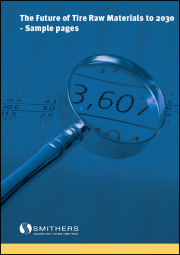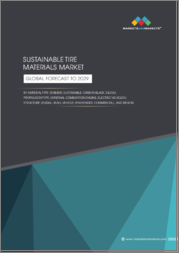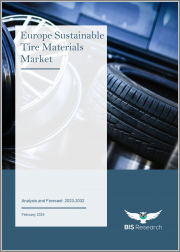
|
시장보고서
상품코드
1389584
아시아태평양의 지속가능 타이어 소재 시장 : 분석과 예측(2023-2032년)Asia-Pacific Sustainable Tire Materials Market - Analysis and Forecast, 2023-2032 |
||||||
중국을 제외한 아시아태평양의 지속가능 타이어 소재 시장 규모는 2022년 100만 달러에서 예측 기간 중 19.08%의 CAGR로 추이하며, 2032년에는 510만 달러 규모로 성장할 것으로 예측됩니다.
친환경 타이어에 대한 수요의 증가, 신흥 시장의 개발, 자동차·트럭용 타이어의 제조 공정에서 지속가능 타이어 소재의 채택 등에 의해 지속가능 타이어 소재 시장은 성장할 것으로 예측되고 있습니다.
유해한 탄소 배출과 환경에 대한 악영향은 타이어 제조에서 재생 불가능한 자원의 사용에 관련되어 있습니다. 아시아태평양의 주요 타이어 제조업체는 이 문제에 대처하기 위해 연비 개선, 수명 단축, 탄소발자국 저감을 실현한 지속가능한 타이어의 제조에 주력하고 있습니다. 이 지역의 주요 국가는 환경에 대한 영향을 경감하기 위해 높은 목표를 세우고 있으며, 이 지속가능한 타이어 소재는 목표에 부합하고 있습니다. 또한 지속가능한 타이어 소재 분야에서 R&D에 중점이 놓이게 된 결과, 새롭고 독창적인 지속가능한 타이어 솔루션이 등장할 것으로 예상됩니다. 친환경 타이어 소재 시장은 아직 초기 단계에 있으나, 예측 기간 중 대폭 확대할 것으로 예상되고 있습니다.
아시아태평양의 지속가능 타이어 소재 시장을 조사했으며, 시장 배경·개요, 특허 동향, 법규제 환경, 시장 성장에 대한 각종 영향요인 분석, 시장 규모의 추이·예측, 각종 구분·주요 국가별 상세 분석, 경쟁 구도, 주요 기업의 분석 등을 정리하여 전해드립니다.
| 주요 시장 통계 | |
|---|---|
| 예측 기간 | 2023-2032년 |
| 2023년 평가 | 100만 달러 |
| 2032년 예측 | 510만 달러 |
| CAGR | 19.08% |
시장의 분류
세분화 1 : 소재 유형별
- 고무
- 천연
- 재활용
- 지속가능 카본블랙
- 실리카
- 기타
세분화 2 : 추진 유형별
- 내연 엔진차
- 전기자동차
세분화 3 : 자동차 유형별
- 승용차
- 상용차
세분화 4 : 타이어 구조별
- 레이디얼
- 바이어스
세분화 5 : 판매채널별
- OEM
- 애프터마켓
세분화 6 : 지역별
- 아시아태평양 및 일본 : 일본, 한국, 인도, 기타
주요 기업 :
- LDC-KOREA CO., LTD.
- GRP LTD.
- SNR Reclamations Pvt. Ltd.
- Bridgestone Corporation
목차
제1장 시장
- 업계의 전망
- 업계의 동향
- 공급망 네트워크
- 주요 특허 분석
- 타이어 재활용의 개요
- 타이어 소재 시장에 관한 규제
- 사업 역학
- 사업 촉진요인
- 사업상 과제
- 사업 전략
- 기업 전략
- 사업 기회
제2장 지역
- 중국
- 시장
- 용도
- 제품
- 아시아태평양 및 일본
- 시장
- 용도
- 제품
- 국가 레벨 분석
제3장 시장 : 경쟁 벤치마킹·기업 개요
- 경쟁 벤치마킹
- 지속가능 타이어 소재 제조업체의 경쟁 매트릭스
- 타이어 제조업체의 시장 점유율 분석
- 기업 개요
- 유형 1 기업 : 지속가능 타이어 소재 제조업체
제4장 조사 방법
KSA 23.12.08“The Asia-Pacific Sustainable Tire Materials Market (excluding China) Expected to Reach $5.1 Million by 2032.”
Introduction to Asia-Pacific Sustainable Tire Materials Market
The Asia-Pacific sustainable tire materials market (excluding China) is projected to reach $5.1 million by 2032 from $1.0 million in 2022, growing at a CAGR of 19.08% during the forecast period 2023-2032. The market for sustainable tire materials is anticipated to rise as a result of the increasing demand for environmentally friendly tires, new developments, and the incorporation of sustainable tire materials during the production process of tires for cars and trucks.
Market Introduction
| KEY MARKET STATISTICS | |
|---|---|
| Forecast Period | 2023 - 2032 |
| 2023 Evaluation | $1.0 Million |
| 2032 Forecast | $5.1 Million |
| CAGR | 19.08% |
Harmful carbon emissions and detrimental effects on the environment are linked to the use of non-renewable resources in tire production. Leading APAC tire producers, including Michelin and The Goodyear Tire and Rubber Company, are now making sustainable tires with improved fuel efficiency, a shorter lifespan, and a lower carbon footprint in order to address this problem. The region's leading nations have set high goals to lessen their influence on the environment, and these sustainable tire materials meet those goals. It is also anticipated that new and creative sustainable tire solutions will be introduced as a result of the increased focus on research and development in the area of sustainable tire materials. While the market for environmentally friendly tire materials is still in its infancy, it is expected to increase significantly in the forecasted period.
Market Segmentation:
Segmentation 1: by Type of Material
- Rubber
- Natural
- Recycled
- Sustainable Carbon Black
- Silica
- Others
Segmentation 2: by Propulsion Type
- Internal Combustion Engine Vehicles
- Electric Vehicles
Segmentation 3: by Vehicle Type
- Passenger Vehicles
- Commercial Vehicles
Segmentation 4: by Tire Structure
- Radial
- Bias
Segmentation 5: by Sales Channel
- OEMs
- Aftermarket
Segmentation 6: by Region
- Asia-Pacific and Japan: Japan, South Korea, India, and Rest-of-Asia-Pacific and Japan
How can this report add value to an organization?
Product/Innovation Strategy: In Asia-Pacific, the leading sustainable tire materials manufacturers are continuously working to develop new and innovative sustainable tire materials. The growing need for efficient, eco-friendly, and high-performing tires is one of the major factors for the growth of the sustainable tire materials market. The market is more on the consolidated side at present, where sustainable tire material manufacturers have been successful to a certain extent in strengthening their market position in the global market, with a few sustainable tire material manufacturers developing recovered carbon black, recycled rubber, and sustainable silica for sustainable tires. However, the competition in the market is expected to become intense as the demand for sustainable tire material increases from tire manufacturers to achieve sustainability targets. Moreover, partnerships and collaborations are expected to play a crucial role in strengthening market position over the coming years, with the companies focusing on bolstering their technological capabilities and gaining a dominant market share in the sustainable tire material industry.
Growth/Marketing Strategy: The sustainable tire materials market has been growing at a rapid pace. The market offers enormous opportunities for existing and emerging market players. Some of the strategies covered in this segment are mergers and acquisitions, product launches, partnerships and collaborations, business expansions, and investments. The strategies preferred by companies to maintain and strengthen their market position primarily include partnerships, agreements, and collaborations.
Competitive Strategy: The key players in the sustainable tire materials market analyzed and profiled in the study include multiple sustainable tire material manufacturers and tire manufacturers. Moreover, a detailed competitive benchmarking of the players operating in the sustainable tire materials market has been done to help the reader understand the ways in which players stack against each other, presenting a clear market landscape. Additionally, comprehensive competitive strategies such as partnerships, agreements, and collaborations are expected to aid the reader in understanding the untapped revenue pockets in the market.
Key Market Players and Competition Synopsis
The companies that are profiled have been selected based on inputs gathered from primary experts and analysing company coverage, product portfolio, and market penetration.
Some of the prominent names established in this market are:
|
|
Table of Contents
1 Markets
- 1.1 Industry Outlook
- 1.1.1 Industry Trends
- 1.1.1.1 Change in Business Models of Companies Due to Climate Action
- 1.1.1.2 Increasing Allocation of Funds Toward Environment-Friendly Tire Material Technologies
- 1.1.2 Supply Chain Network
- 1.1.3 Key Patents Analysis
- 1.1.4 Overview of Tire Recycling
- 1.1.5 Regulations on Tire Materials Market
- 1.1.1 Industry Trends
- 1.2 Business Dynamics
- 1.2.1 Business Drivers
- 1.2.1.1 Stringent Regulations and Carbon Neutrality Targets
- 1.2.1.2 Augmented Demand for Sustainable Tire Materials from Transportation and Logistics
- 1.2.1.3 Extended Lifespan and Cost Efficiency of Tires
- 1.2.2 Business Challenges
- 1.2.2.1 Volatility of Tire Prices Made from Sustainable Tire Materials
- 1.2.2.2 Lower Adoption Rate of Sustainable Tire Materials in ICE Vehicles Compared to Electric Vehicles
- 1.2.3 Business Strategies
- 1.2.3.1 Product Developments
- 1.2.3.2 Market Developments
- 1.2.4 Corporate Strategies
- 1.2.4.1 Mergers, Acquisitions, and Divestments
- 1.2.4.2 Partnerships, Joint Ventures, Collaborations, and Alliances
- 1.2.5 Business Opportunities
- 1.2.5.1 Growing Demand for New Sustainable Tire Materials
- 1.2.5.2 Utilization of Advanced Recycling Techniques within the Tire Circular Economy Model
- 1.2.1 Business Drivers
2 Regions
- 2.1 China
- 2.1.1 Market
- 2.1.1.1 Buyer Attributes
- 2.1.1.2 Key Manufacturers in China
- 2.1.1.3 Competitive Benchmarking
- 2.1.1.4 Business Challenges
- 2.1.1.5 Business Drivers
- 2.1.2 Application
- 2.1.2.1 China Sustainable Tire Materials Market (by Vehicle Type), Volume and Value Data
- 2.1.2.2 China Sustainable Tire Materials Market (by Tire Structure), Volume and Value Data
- 2.1.2.3 China Sustainable Tire Materials Market (by Propulsion Type), Volume and Value Data
- 2.1.2.4 China Sustainable Tire Materials Market (by Sales Channel), Volume and Value Data
- 2.1.3 Product
- 2.1.3.1 China Sustainable Tire Materials Market (by Type of Material), Volume and Value Data
- 2.1.1 Market
- 2.2 Asia-Pacific and Japan
- 2.2.1 Market
- 2.2.1.1 Buyer Attributes
- 2.2.1.2 Key Manufacturers in Asia-Pacific and Japan
- 2.2.1.3 Competitive Benchmarking
- 2.2.1.4 Business Challenges
- 2.2.1.5 Business Drivers
- 2.2.2 Application
- 2.2.2.1 Asia-Pacific and Japan Sustainable Tire Materials Market (by Vehicle Type), Volume and Value Data
- 2.2.2.2 Asia-Pacific and Japan Sustainable Tire Materials Market (by Tire Structure), Volume and Value Data
- 2.2.2.3 Asia-Pacific and Japan Sustainable Tire Materials Market (by Propulsion Type), Volume and Value Data
- 2.2.2.4 Asia-Pacific and Japan Sustainable Tire Materials Market (by Sales Channel), Volume and Value Data
- 2.2.3 Product
- 2.2.3.1 Asia-Pacific and Japan Sustainable Tire Materials Market (by Type of Material), Volume and Value Data
- 2.2.4 Asia-Pacific and Japan: Country-Level Analysis
- 2.2.4.1 Japan
- 2.2.4.1.1 Buyer Attributes
- 2.2.4.1.1.1 Key Manufacturers in Japan
- 2.2.4.1.1.2 Business Challenges
- 2.2.4.1.1.3 Business Drivers
- 2.2.4.1.2 Application
- 2.2.4.1.2.1 Japan Sustainable Tire Materials Market (by Vehicle Type), Volume and Value Data
- 2.2.4.1.2.2 Japan Sustainable Tire Materials Market (by Tire Structure), Volume and Value Data
- 2.2.4.1.2.3 Japan Sustainable Tire Materials Market (by Propulsion Type), Volume and Value Data
- 2.2.4.1.3 Product
- 2.2.4.1.3.1 Japan Sustainable Tire Materials Market (by Type of Material), Volume and Value Data
- 2.2.4.1.1 Buyer Attributes
- 2.2.4.2 South Korea
- 2.2.4.2.1 Market
- 2.2.4.2.1.1 Buyer Attributes
- 2.2.4.2.1.2 Key Manufacturers in South Korea
- 2.2.4.2.1.3 Business Challenges
- 2.2.4.2.1.4 Business Drivers
- 2.2.4.2.2 Application
- 2.2.4.2.2.1 South Korea Sustainable Tire Materials Market (by Vehicle Type), Volume and Value Data
- 2.2.4.2.2.2 South Korea Sustainable Tire Materials Market (by Tire Structure), Volume and Value Data
- 2.2.4.2.2.3 South Korea Sustainable Tire Materials Market (by Propulsion Type), Volume and Value Data
- 2.2.4.2.3 Product
- 2.2.4.2.3.1 South Korea Sustainable Tire Materials Market (by Type of Material), Volume and Value Data
- 2.2.4.2.1 Market
- 2.2.4.3 India
- 2.2.4.3.1 Market
- 2.2.4.3.1.1 Buyer Attributes
- 2.2.4.3.1.2 Key Manufacturers in India
- 2.2.4.3.1.3 Business Challenges
- 2.2.4.3.1.4 Business Drivers
- 2.2.4.3.2 Application
- 2.2.4.3.2.1 India Sustainable Tire Materials Market (by Vehicle Type), Volume and Value Data
- 2.2.4.3.2.2 India Sustainable Tire Materials Market (by Tire Structure), Volume and Value Data
- 2.2.4.3.2.3 India Sustainable Tire Materials Market (by Propulsion Type), Volume and Value Data
- 2.2.4.3.3 Product
- 2.2.4.3.3.1 India Sustainable Tire Materials Market (by Type of Material), Volume and Value Data
- 2.2.4.3.1 Market
- 2.2.4.4 Rest-of-Asia-Pacific and Japan
- 2.2.4.4.1 Market
- 2.2.4.4.1.1 Buyer Attributes
- 2.2.4.4.1.2 Key Manufacturers in Rest-of-Asia-Pacific and Japan
- 2.2.4.4.1.3 Business Challenges
- 2.2.4.4.1.4 Business Drivers
- 2.2.4.4.2 Application
- 2.2.4.4.2.1 Rest-of-Asia-Pacific and Japan Sustainable Tire Materials Market (by Vehicle Type), Volume and Value Data
- 2.2.4.4.2.2 Rest-of-Asia-Pacific and Japan Sustainable Tire Materials Market (by Tire Structure), Volume and Value Data
- 2.2.4.4.2.3 Rest-of-Asia-Pacific and Japan Sustainable Tire Materials Market (by Propulsion Type), Volume and Value Data
- 2.2.4.4.3 Product
- 2.2.4.4.3.1 Rest-of-Asia-Pacific and Japan Sustainable Tire Materials Market (by Type of Material), Volume and Value Data
- 2.2.4.4.1 Market
- 2.2.4.1 Japan
- 2.2.1 Market
3 Markets - Competitive Benchmarking & Company Profiles
- 3.1 Competitive Benchmarking
- 3.1.1 Competitive Position Matrix for Sustainable Tire Materials Manufacturers
- 3.2 Market Share Analysis for Tire Manufacturers
- 3.3 Company Profiles
- 3.3.1 Type 1 Companies: Sustainable Tire Material Manufacturers
- 3.3.1.1 LDC-KOREA CO., LTD.
- 3.3.1.1.1 Company Overview
- 3.3.1.1.2 Role of LDC-KOREA CO., LTD. in the Sustainable Tire Materials Market
- 3.3.1.1.2.1 Product Portfolio
- 3.3.1.1.3 Analyst View
- 3.3.1.2 GRP LTD.
- 3.3.1.2.1 Company Overview
- 3.3.1.2.2 Role of GRP LTD. in the Sustainable Tire Materials Market
- 3.3.1.2.2.1 Product Portfolio
- 3.3.1.2.3 Analyst View
- 3.3.1.3 SNR Reclamations Pvt. Ltd.
- 3.3.1.3.1 Company Overview
- 3.3.1.3.2 Role of SNR Reclamations Pvt. Ltd. in the Sustainable Tire Materials Market
- 3.3.1.3.2.1 Product Portfolio
- 3.3.1.3.3 Analyst View
- 3.3.1.4 Bridgestone Corporation
- 3.3.1.4.1 Company Overview
- 3.3.1.4.2 Role of Bridgestone Corporation in the Sustainable Tire Materials Market
- 3.3.1.4.2.1 Product Portfolio
- 3.3.1.4.3 Business Strategies
- 3.3.1.4.3.1 Product Developments
- 3.3.1.4.4 R&D Analysis
- 3.3.1.4.5 Analyst View
- 3.3.1.1 LDC-KOREA CO., LTD.
- 3.3.1 Type 1 Companies: Sustainable Tire Material Manufacturers
4 Research Methodology
- 4.1 Data Sources
- 4.1.1 Primary Data Sources
- 4.1.2 Secondary Data Sources
- 4.1.3 Data Triangulation
- 4.2 Market Estimation and Forecast
- 4.2.1 Research Methodology - Bottom - Up Approach
- 4.2.2 Factors for Data Prediction and Modeling



















